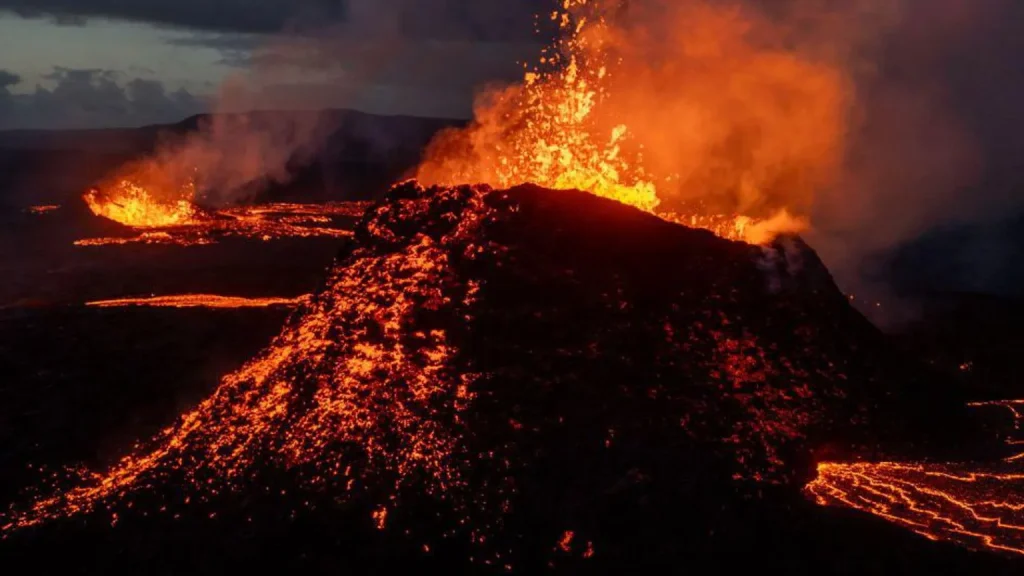
Traditional Volcanic Monitoring vs. New Methods
In one of the world’s volcanic hotspots, northeast Iceland near the Krafla volcano, scientists are embarking on a groundbreaking magma research mission. The Krafla Magma Testbed (KMT) project aims to drill into magma beneath the volcano to understand its behavior better. This magma research could lead to more accurate eruption predictions and advance geothermal energy technology by tapping into an extremely hot and potentially limitless power source.
Krafla Magma Testbed: The Plan
The KMT project, led by Bjorn Por Guðmundsson and an international team of scientists, plans to drill two boreholes starting in 2026. The first borehole will be drilled about 2.1 km (1.3 miles) underground to create an underground magma observatory. The team believes that this effort will be transformative, much like a “moonshot” for earth science, as stated by Yan Lavelle, a professor of vulcanology at the Ludwigs-Maximilian University in Munich.
Traditional Volcanic Monitoring vs. New Methods
Traditionally, volcanic activity is monitored using tools like seismometers. However, unlike surface lava, scientists still lack a thorough understanding of magma deep below the earth. Pressure and temperature sensors will be placed in the magma to gain insights into how it behaves underground. This data could improve eruption forecasting and save lives.
Volcanic Hazards and Energy Opportunities
Around 800 million people worldwide live within 100 km of active volcanoes. Better understanding of magma could lead to improved safety for those communities. Iceland itself has 33 active volcanic systems, including the infamous Eyjafjallajökull, which erupted in 2010, disrupting air travel globally and costing billions of dollars. Mr. Guðmundsson believes that better predictive tools could have saved money and reduced disruption.
The KMT project’s second borehole aims to develop new geothermal power generation methods by directly exploiting magma’s extreme heat. Magma is the energy source behind geothermal systems, so tapping directly into it could be a game changer for geothermal energy.
Potential Game Changer for Geothermal Energy
Currently, 65% of Iceland’s electricity and 85% of its household heating come from geothermal energy. Most geothermal systems utilize hot fluids found deep underground, but magma itself offers far greater energy potential. In 2009, Icelandic engineers made a chance discovery when a borehole unexpectedly hit magma at just 2.1 km depth. This well produced ten times more energy than the average geothermal well in the area, highlighting the immense power that magma could offer.
The Krafla power plant currently uses geothermal resources to supply electricity and hot water to about 30,000 homes. Drilling closer to magma, according to Bjarni Pálsson, the executive director of geothermal development at Landsvirkjun, could revolutionize geothermal energy by vastly increasing its efficiency and output.
Challenges in Drilling Magma
Drilling into magma comes with numerous technical challenges, including extreme temperatures and corrosive conditions. The KMT project plans to use specialized materials, such as high-grade nickel alloys and titanium, to withstand the harsh environment. Sigrun Nanna Karlsdottir, a professor of industrial and mechanical engineering at the University of Iceland, is leading efforts to identify materials that can withstand temperatures exceeding 200°C.
Ensuring Safety in Magma Drilling
Drilling into magma may sound risky, but Mr. Guðmundsson is confident it is safe. He points to the 2009 incident, noting that similar drillings may have occurred before without significant issues. Other risks, such as toxic gases and earthquakes, are also being evaluated. However, the geological environment in Iceland makes these risks minimal.
A Global Effort for a Transformative Goal
The KMT project has drawn the attention of scientists and geothermal experts worldwide. Rosalind Archer, dean of Griffith University and former director of the Geothermal Institute in New Zealand, calls drilling into super-hot rock the “Holy Grail” of geothermal energy. Ultra-deep geothermal systems have the potential to produce five to ten times more energy than conventional wells, and KMT’s efforts could lead to a major breakthrough.
The road ahead will be long and filled with challenges, but the potential benefits—improved volcanic forecasting and highly efficient geothermal power—make it worth pursuing. As Prof. Archer notes, the entire geothermal world is watching the KMT project, and it has the potential to transform the field.
External link: BBC article on Krafla volcano drilling
Internal link: Related articles on geothermal energy





